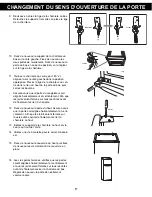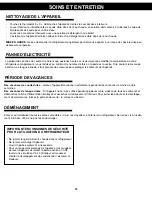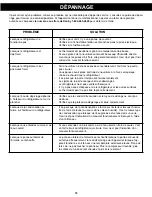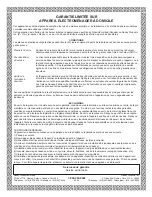
OPERATING INSTRUCTIONS
5
INTERIOR LIGHT
When you open the door the light will be ON automatically. When you close the door the light will turn OFF automatically.
DEFROSTING YOUR APPLIANCE
When?
For the most efficient operation and minimum energy consumption, defrost the freezer compartment when the frost
•
on the appliance walls is excessive or ¼ inch thick. There is no need to defrost the refrigerator compartment, because ice
depositing on the inner back wall is defrosted automatically. Ice may deposit on the inner back wall during the compressor
operation; later on, when the compressor is not operating the ice will defrost and the water drops collect and drain through
the outlet in the inner back wall into the drain pan situated above the compressor, from where is evaporates.
How?
•
CAUTION
Do not use boiling water because it may damage the plastic parts. In addition, never use a sharp or metallic instrument to
remove frost as it may damage the cooling coils and will void the warranty. We recommend using a plastic scraper.
Reset the thermostat to the “0” position and disconnect the power supply.
•
Remove the frozen food from the appliance and place it in a cooler to protect the food.
•
Leave the door open for a while so that you can easily scrap off the frost.
•
Use a plastic scraper but be careful not to damage the inner surfaces of the freezer.
•
Wipe up the scraped off frost and ice before it is completely defrosted.
•
FREEZING FRESH FOODS
Proper use of the appliance, adequately packed food, correct temperature and taking into account hygienic precautions will
•
substantially influence the quality of freezing the food or storing of the frozen foods.
This compartment is designed for the long-term storage of frozen food.
•
The storage life of frozen foods varies and the recommended storage time should not be exceeded.
•
Pre-packed commercially frozen food should be stored in accordance with the frozen foods manufacturer’s instructions for a
•
three star frozen food storage compartment or home freezer.
Place frozen food into the freezer as quickly as possible after purchase. If there are instructions on the packet, carefully fol-
•
low these instructions regarding storage times.
Carefully select food you intend to freeze, it should be of adequate quality and suitable for freezing.
•
Use correct packaging and wrap it tight.
•
The packaging should be airtight and shouldn’t leak since this could cause substantial vitamin loss and dehydration of foods.
•
Foils and bags should be soft enough to tightly wrap around the foods.
•
When preparing foods to be frozen, consider sanitary precautions.
•
Mark packages with following data: kind and amount of foods and the date of loading.
•
It is extremely important that the food is frozen as quickly as possible.
•
If the loading amount is too large, the quality of freezing is reduced which affects the quality of frozen foods.
•






















